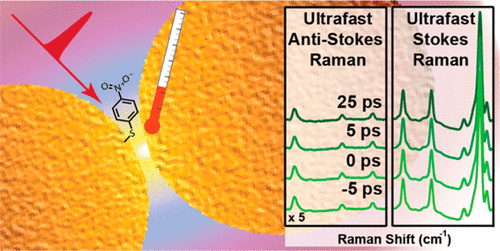Our official English website, www.x-mol.net, welcomes your feedback! (Note: you will need to create a separate account there.)
Ultrafast Nanoscale Raman Thermometry Proves Heating Is Not a Primary Mechanism for Plasmon-Driven Photocatalysis
ACS Nano ( IF 17.1 ) Pub Date : 2018-06-08 00:00:00 , DOI: 10.1021/acsnano.8b01809 Emily L. Keller 1 , Renee R. Frontiera 1
ACS Nano ( IF 17.1 ) Pub Date : 2018-06-08 00:00:00 , DOI: 10.1021/acsnano.8b01809 Emily L. Keller 1 , Renee R. Frontiera 1
Affiliation

|
Plasmonic materials efficiently convert light to various forms of energies for many applications, including photocatalysis, photovoltaics, and photothermal therapies. In particular, plasmonic photocatalysts hold incredible promise for highly selective sunlight-driven catalysis through the generation of highly energetic holes and electrons used to drive chemical reactions. However, plasmons are also known to generate heat, and the partitioning of photoexcitation energy into hot carriers and heat on molecularly relevant time scales is not well understood, yet plays a crucial role in designing and understanding these photocatalysts. Using an ultrafast surface-enhanced Raman thermometry technique, we probe the effective temperature, equivalent to the mode-specific increase of vibrational kinetic energy, of molecules adsorbed to gold nanoparticle aggregates in the most active hot spots on the picosecond time scale of chemical reactivity. This represents the first measurement of vibrational energy deposition for coupled molecular–plasmonic systems on the picosecond time scale of molecular motion. We find that upon plasmon excitation, the adsorbates in the hot spots undergo an initial energy transfer within several picoseconds that changes the effective temperature of the system by less than 100 K, even at peak flux values 108 times stronger than focused sunlight. The energy quickly dissipates from the adsorbates into the surroundings in less than 5 ps, even at the highest values of photoexcitation. This surprisingly modest energy transfer of the most active regions of the plasmonic materials on the ultrafast time scale decisively proves that most plasmonic photocatalysis is not primarily thermally driven.
中文翻译:

超快纳米拉曼测温证明加热不是等离激元驱动的光催化的主要机理
等离子体材料有效地将光转换为多种形式的能量,用于许多应用,包括光催化,光伏和光热疗法。尤其是,等离激元光催化剂通过产生高能空穴和电子来驱动化学反应,具有极高的选择性,可用于由阳光驱动的高选择性催化。然而,还已知等离子体激元产生热量,并且在分子相关的时间尺度上光激发能在热载体中的分配和热的分配还没有被很好地理解,但是在设计和理解这些光催化剂中起着至关重要的作用。使用超快表面增强拉曼测温技术,我们探测了有效温度,相当于振动动能的特定模式增加,在皮秒级化学反应时间尺度上,最活跃的热点上吸附到金纳米颗粒聚集体上的分子的数量。这代表了在皮秒级的分子运动时对耦合的分子-等离子体系统的振动能量沉积的首次测量。我们发现,在等离子体激元激发下,热点中的被吸附物在几皮秒内经历了一次初始能量传递,即使在峰值通量值为10的情况下,系统的有效温度也改变了不到100K。比聚焦阳光强8倍。即使在最高的光激发值下,能量也能在不到5 ps的时间内迅速从被吸附物中耗散到周围环境中。超快时间尺度上等离激元材料最活跃区域的这种令人惊讶的适度能量转移,决定性地证明了大多数等离激元光催化不是主要由热驱动的。
更新日期:2018-06-08
中文翻译:

超快纳米拉曼测温证明加热不是等离激元驱动的光催化的主要机理
等离子体材料有效地将光转换为多种形式的能量,用于许多应用,包括光催化,光伏和光热疗法。尤其是,等离激元光催化剂通过产生高能空穴和电子来驱动化学反应,具有极高的选择性,可用于由阳光驱动的高选择性催化。然而,还已知等离子体激元产生热量,并且在分子相关的时间尺度上光激发能在热载体中的分配和热的分配还没有被很好地理解,但是在设计和理解这些光催化剂中起着至关重要的作用。使用超快表面增强拉曼测温技术,我们探测了有效温度,相当于振动动能的特定模式增加,在皮秒级化学反应时间尺度上,最活跃的热点上吸附到金纳米颗粒聚集体上的分子的数量。这代表了在皮秒级的分子运动时对耦合的分子-等离子体系统的振动能量沉积的首次测量。我们发现,在等离子体激元激发下,热点中的被吸附物在几皮秒内经历了一次初始能量传递,即使在峰值通量值为10的情况下,系统的有效温度也改变了不到100K。比聚焦阳光强8倍。即使在最高的光激发值下,能量也能在不到5 ps的时间内迅速从被吸附物中耗散到周围环境中。超快时间尺度上等离激元材料最活跃区域的这种令人惊讶的适度能量转移,决定性地证明了大多数等离激元光催化不是主要由热驱动的。


























 京公网安备 11010802027423号
京公网安备 11010802027423号